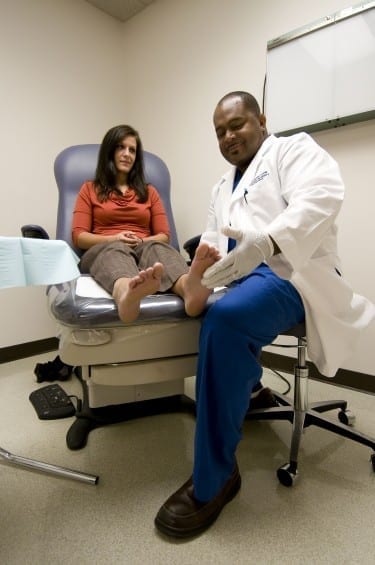
Diabetes is a serious and potentially deadly disease that requires major lifestyle changes. In addition to healthy eating and exercise habits, diabetics must monitor their blood glucose, administer insulin when necessary and care for their feet.
Foot problems are a leading cause of hospitalization for people with diabetes, yet the feet are often forgotten in the day-to-day management of the disease. Diabetics can develop poor circulation to the feet, loss of sensation and severe infections.
“Diabetes has a lot of secondary complications associated with it. Diabetics can have sensational impairment, changes in the skin, ulcers and non-healing wounds,” says John Bennett, D.P.M., FACFAS, Des Moines University Foot and Ankle physician and associate professor in the DMU College of Podiatric Medicine and Surgery. “If not managed correctly, common problems have the ability to progress into much more.”
Most foot problems are preventable, so proactive care is crucial. Bennett suggests following these guidelines to keep your feet healthy:
- Inspect your feet for blisters, bleeding and sores between the toes. “Look at the skin to see if there are any breaks. If you can’t reach or see your feet, use a mirror or have somebody else inspect the bottom of your feet,” advises Bennett.
- Wash and moisturize your feet to keep the skin clean and hydrated. Be sure to dry them well — especially between the toes, where bacteria like to hide.
- Avoid extreme temperatures that can damage your skin. Use your hands to gauge the water temperature before getting in the shower or bath.
- Don’t perform “bathroom surgery” on corns, calluses or ingrown toenails. One small slip-up can lead to an open wound that invites infection or fails to heal properly. Bennett recommends using a coarse pumice stone instead of a sharp object or chemical product, which can do more harm than good.
The most important thing you can do to prevent diabetic foot problems is have a regular examination by a foot and ankle specialist. They will perform their own visual inspection and assess any areas at risk for problems. Patients with no underlying issues only need a check up once or twice a year, but those with complications need to be seen once every two or three months.
“It’s important that you’re proactive. A lot of things can actually be prevented or avoided through patient care,” Bennett says. “An appropriate diet, exercise, good foot care — if you’re doing what you’re supposed to be doing, you’re not likely to have a lot of problems.”

